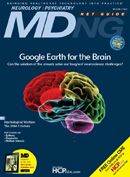Publication
Article
MDNG Neurology
Psych in Film: Recalling Total Recall
Author(s):
Total Recall revolves around conflicts between true and false perceptions.
Total Recall(1990) turned twenty-one this year. A remake starring Colin Farrell is in the works. That should not be surprising, given the timelessness of the Philip K. Dick novella that inspired the film. Dick published “We Can Remember It for You Wholesale” in 1966 (http://hcp.lv/e2aejg), as intrigue with LSD increased, and as questions about the parallels between hallucinogen-induced perceptions and material “reality” peaked.
We can say that Dick was simply footnoting Plato’s “The Allegory of the Cave” (http://hcp.lv/dGXE7j), which also pits perceived reality against material reality. Plato described prisoners who are confined to a cave, facing a wall, capable of seeing only shadows cast by passers-by. Upon being freed, and able to see original objects as well as cast shadows, the former prisoners refuse to believe that the shadows do not represent reality.
On the surface, Total Recall appears to be an action-adventure fantasy film. In reality, it too, revolves around conflicts between true and false perceptions. Conveniently, cyberspace came of age shortly before the film’s release. Expressions like “memory chips” and “virtual reality” infiltrated everyday vocabularies. Both scholars and armchair academicians contrasted the “real self” with the second “cyber-self.”
So when we see a doctor insert a “memory bolus” into the nose of simple-minded construction worker Douglas Quaid (Arnold Schwarzenegger), we link this procedure with recent technological advances. After all, this same technique is used in neurosurgery. Those who are mindful of Dick’s own drug use history might see the intranasal memory bolus as cocaine, which also became fashionable in the 1980s.
Either way, Quaid dreams of Mars and is dead set on visiting the Red Planet but cannot afford a real Mars vacation. So, he buys a pseudo-vacation from a company called Rekall, which specializes in such products. Years later, a similar company named “Lacuna” will appear in Eternal Sunshine of the Spotless Mind (2004).
Quaid expects to experience a pseudo-action-adventure excursion on Mars. Little does he know that he once lived on Mars, where he was a spy, rather than a simple laborer. As is typical of Dick stories (and Freud’s theories), dreams lead to the truth.
But there is a glitch. When the doctor attempts to insert the memory bolus, he finds another bolus already in place, one that has blocked Quaid’s memory of his identity and obliterated recall of his political trysts on Mars. That revelation invites the obligatory fistfight, as befits a character played by a world-class body builder.
Then the action begins. Quaid returns to Mars, recaptures his past, reunites with his real lover (in the Red Light district of the Red Planet), combats evil administrators, and instills good where evil ruled. The motif is mythical.
In retrospect, we realize that setting the story in 2084 foreshadowed the plot. This is an obvious reference to Orwell’s dystopian novel “Nineteen Eighty-Four” (http://hcp.lv/gWLyL2), in which an authoritarian government manipulates its citizens’ perceptions. We can’t help but marvel that bodybuilder-turned-actor Arnold Schwarzenegger convinced Paul Verhoeven (of Robocop fame) to direct this cast-off film and cast him as the everyman who combats corrupt politicos. For Schwarzenegger had not yet run for office. We now gloat over the synchronicity between Arnold’s filmic role and his future role as California’s governor. We see striking parallels between LSD “trips” of the sixties and the pseudo-Mars “trip.”
Many viewers believe that this film deserved more Saturn Awards than it received. Most see the “memory bolus” scene as a peripheral scene that “pushes the plot” and sets up the action that follows. But physicians may think otherwise. Psychiatrists who treat patients who are troubled by flashbacks of traumatic pasts come away troubled by philosophical questions raised by this scene. Neurologists who assess memory loss ponder other clinical and ethical questions.
Since we know that neurosurgeon Penfield unleashed patients’ memories by placing electric probes on their temporal lobes, we are prepared to hear that the brain functions like a computer’s memory card. Dick also knew of Penfield, and referenced him in earlier books.
We now wonder if memory implants will someday be as acceptable as plastic hips. Many will object to the thought, for depriving people of their unique memories also deprives them of their sense of personhood. But what if those memories are scarred by traumas of times past? In those cases, should troublesome memories be replaced, like arthritic joints? What if no viable memories remain, and there is nothing to replace?
This film may end after the credits close, but the questions it raises remain open.
Dr. Packer is an assistant clinical professor, Psychiatry & Behavioral Sciences, Albert Einstein College of Medicine, New York, NY. She is also the author of
Dreams in Myth, Medicin, and Movies, Movies and the Modern Psyche, and Superheroes and Superegos: Analysing the Minds Behind the Masks. Keep an eye out for her forthcoming book Sinister Psychiatrists in Cinema.






